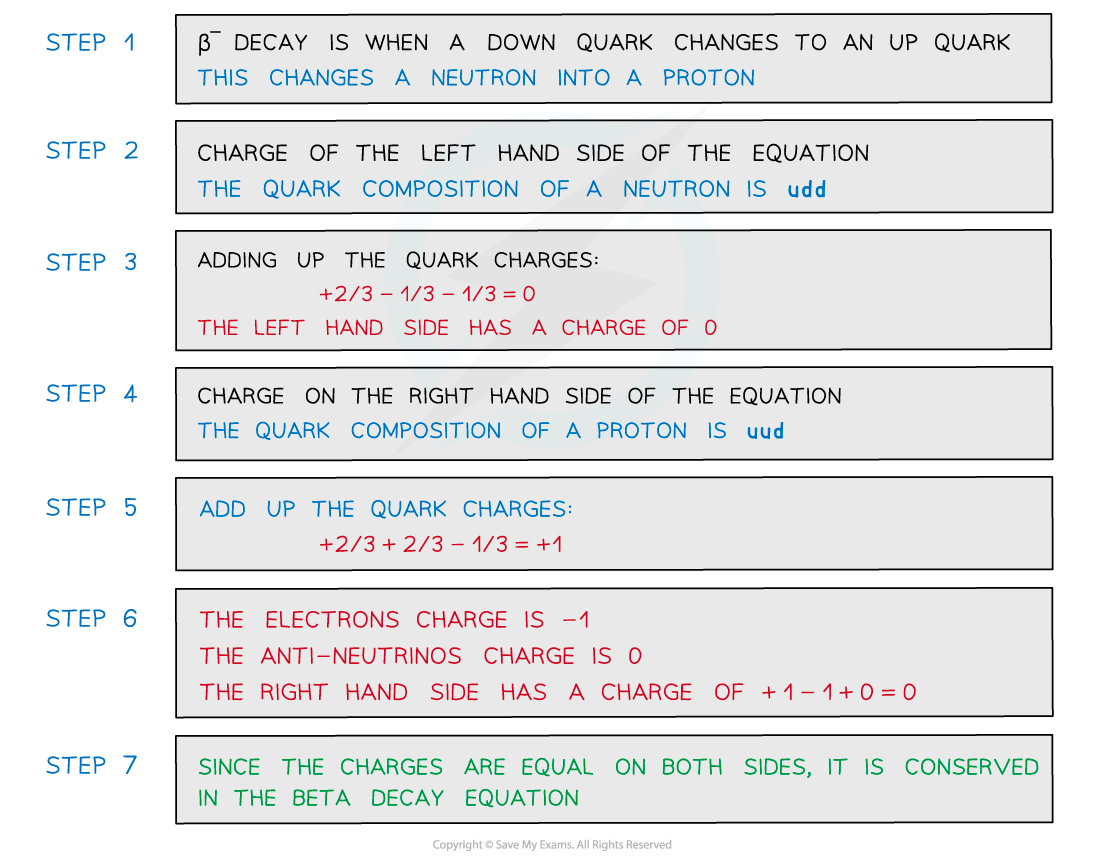Quarks & Leptons
Quarks
- Quarks are fundamental particles that make up other subatomic particles such as protons and neutrons
- Protons and neutrons are in a category of particles called hadrons
Hadrons are defined as any particle made up of quarks
- Fundamental means that quarks are not made up of any other particles. Another example is electrons
- Quarks have never been observed on their own, they’re either in pairs or groups of three
- There are six flavours (types) of quarks that exist:
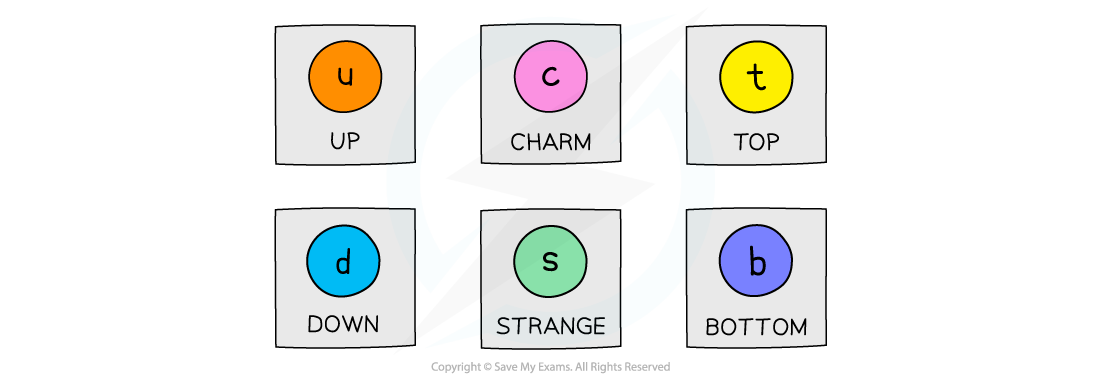
The six flavours of quarks
- The charge of a hadron is determined by the sum of the charges of its quarks
- Each flavour of quark has a certain relative charge:
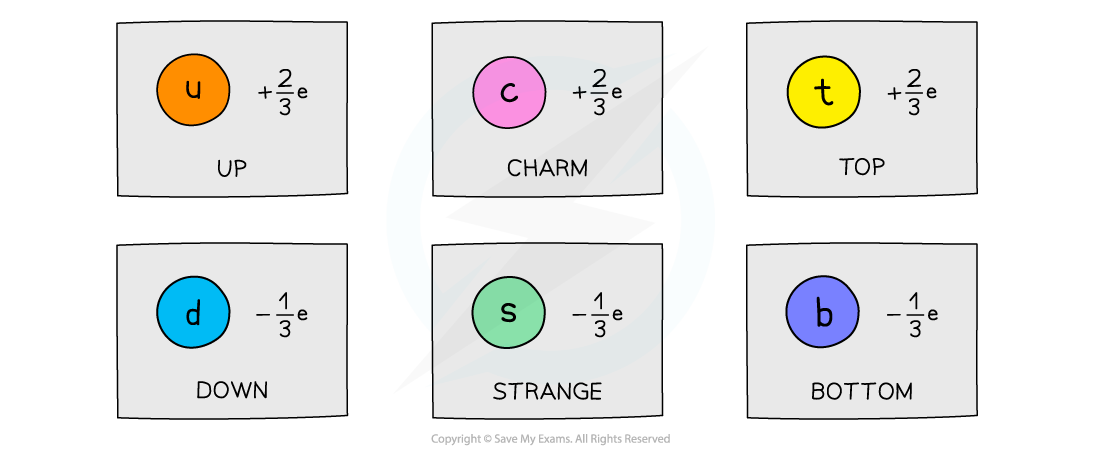
Each flavour of quark has a charge of either +⅔e or -⅓e
- For example, a proton is made up of two up quarks and a down quark. Adding up their charges gives the charge of a proton:
+⅔e + ⅔e - ⅓e = +1e
- The equivalent antiparticle of the quark is the anti-quark
- These are identical to quarks except with opposite relative charges
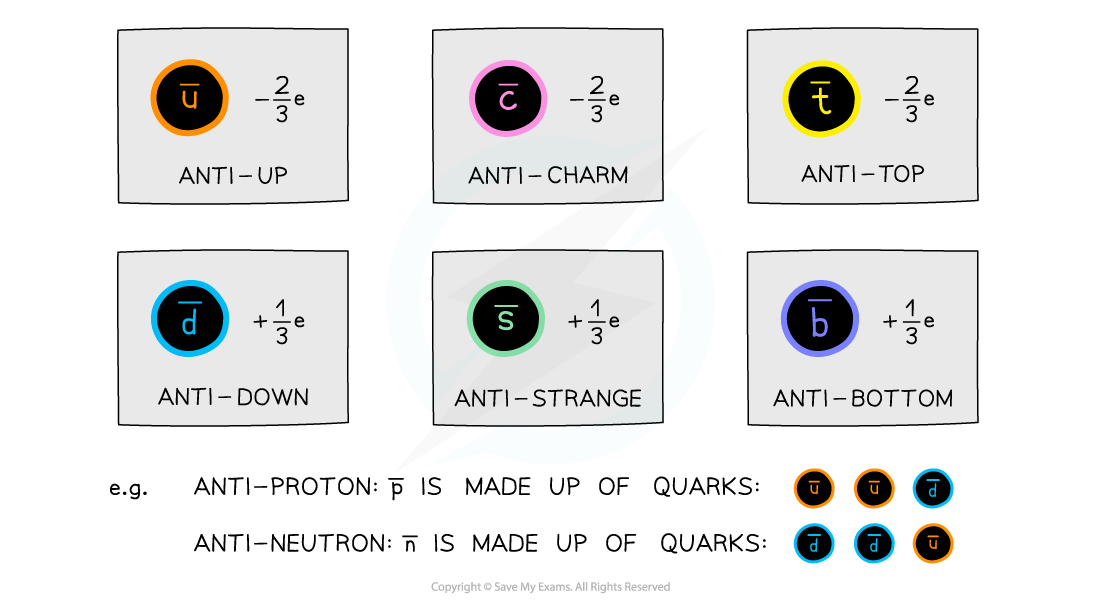
Each flavour of anti-quark has a charge of either -⅔e or +⅓e. The quark composition of anti-protons and anti-neutrons changes to anti-quarks
- Quarks have a baryon number of +1/3
- Anti-quarks having a baryon number of –1/3
- Strange quarks have a strangeness of –1
- Anti-strange quarks have a strangeness of +1
- This is unique to the strange quark
Worked Example
Particles are made up of a combination of three quarks or two quarks. Which quark combination would not give a particle a charge of -1 or 0?
A. up, strange, strange
B. charm, charm, down
C. top, anti-up
D. anti-up, anti-up, anti-strange

Worked Example
A K- particle has a strangeness of –1. Determine the quark structure of this particle.
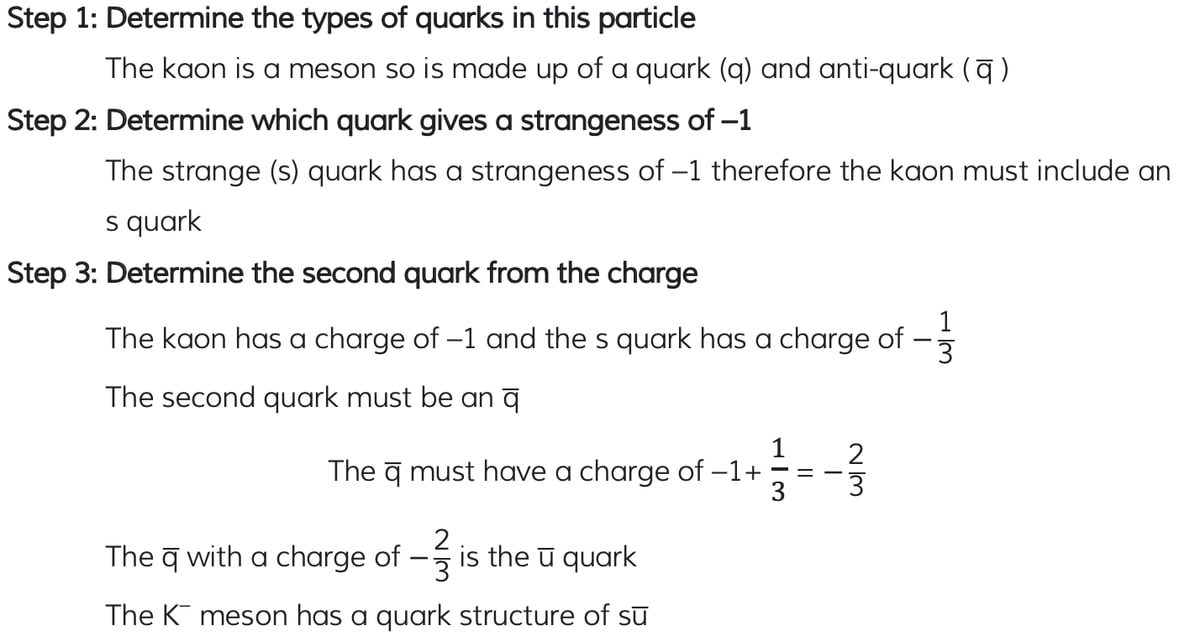
Leptons
- Leptons are a group of fundamental (elementary) particles
- This means they are not made up of any other particles (no quarks)
- There are six leptons altogether:

The six leptons are all fundamental particles
- The muon and tau particle are very similar to the electron but with slightly larger mass
- Electrons, muon, and tau particles all have a charge of -1e and a mass of 0.0005u
- There are three flavours (types) of neutrinos:
- Electron-neutrinos (
) which are emitted with electrons
- Muon-neutrinos (
) which are emitted with muons
- Tau-neutrinos (
) which are emitted with tau particles
- Electron-neutrinos (
- Leptons interact with the weak interaction, electromagnetic and gravitational forces
- However, they do not interact with the strong force
- Although quarks are fundamental particles too, they are not classed as leptons
- Leptons do not interact with the strong force, whilst quarks do
Worked Example
Circle all the anti-leptons in the following decay equation.![]()
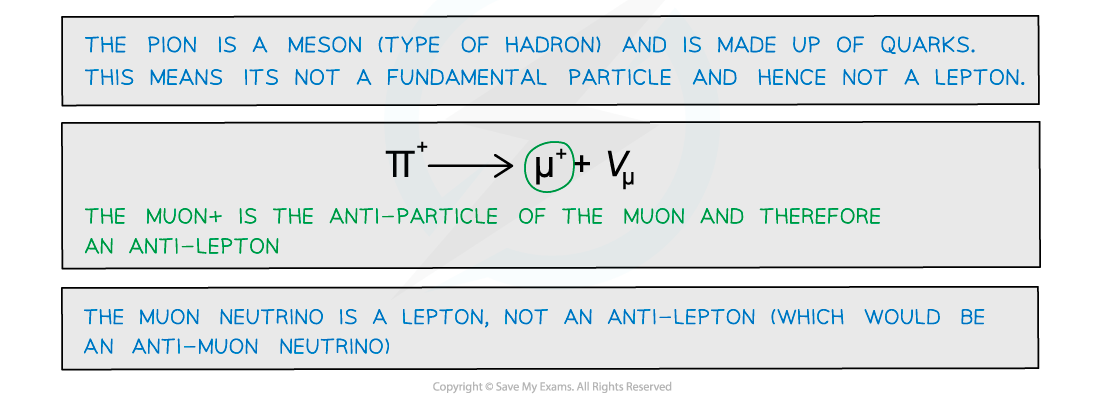
Lepton Number
- Similar to baryon number, the lepton number, L is the number of leptons in an interaction
- L depends on whether the particle is a lepton, anti-lepton or neither
- Leptons have a lepton number L = +1
- Anti-leptons have a lepton number L = –1
- Particles that are not leptons have a lepton number L = 0
- Lepton number is a quantum number and is conserved in all interactions
- This is helpful for knowing whether an interaction is able to happen

The lepton number depends if the particle is a lepton, anti-lepton or neither
Worked Example
If the lepton number is conserved in the following decay, identify whether particle X should be a neutrino or anti-neutrino
Step 1: Determine the lepton number of all the particles on both sides of the equation
- 0 + (–1) = 0 + X
Step 2: Identify the lepton number of X
- If the lepton number must be conserved, X must also have a lepton number of –1
Step 3: State the particle X
- Particle X is an anti-neutrino
Protons & Neutrons
Protons and Neutrons
- Protons and neutrons are not fundamental particles. They are each made up of three quarks
- Protons are made up of two up quarks and a down quark
- Neutrons are made up of two down quarks and an up quark
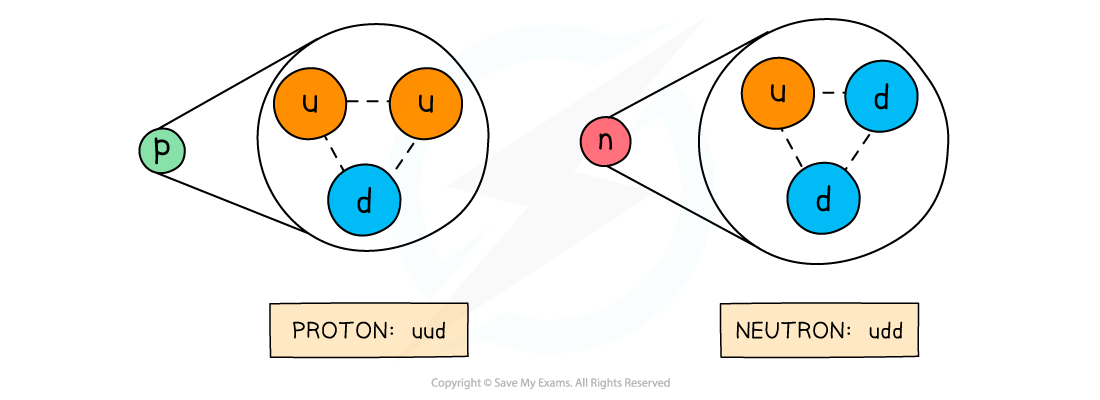
Protons and neutrons are made up of three quarks
- You will be expected to remember these quark combinations for exam questions
Protons as Baryons
- The proton is the most stable baryon
- This means it has the longest half-life of any baryon and is the particle which other baryons eventually decay to
- It is the most stable baryon because it is also the lightest baryon
- Radioactive decay occurs when heavier particles decay into lighter particles
- A decay of the proton would therefore violate the conservation of baryon number
- It is theorized that the proton has a half-life of around 1032 years and research experiments are still underway that are designed to detect proton decay
Worked Example
![]()
Step 1: Calculate number of protons:
-
- The number of protons is from the proton number = 26 protons
Step 2: Calculate number of neutrons:
-
- The number of neutrons = nucleon number - proton number = 56 - 26 = 30 neutrons
Step 3: Up quarks in a proton:
-
- Protons are made up of uud quarks = 2 up quarks
Step 4: Up quarks in a neutron:
-
- Neutrons are made up of udd quarks = 1 up quark
Step 5: Total number of up quarks:
-
- 26 protons x 2 up quarks = 52 up quarks
- 30 neutrons x 1 up quark = 30 up quarks
- 52 + 30 = 82 up quarks
β– and β+ decay
- Beta decay happens via the weak interaction
- This is one of the four fundamental forces and it’s responsible for radioactive decays
Quark Composition: β- decay
- Recall that β- decay is when a neutron turns into a proton emitting an electron and anti-electron neutrino
- More specifically, a neutron turns into a proton because a down quark turns into an up quark

Beta minus decay is when a down quark turns into an up quark
Quark Composition: β+ decay
- Recall that β+ decay is when a proton turns into a neutron emitting a positron and an electron neutrino
- More specifically, a proton turns into a neutron because an up quark turns into a down quark
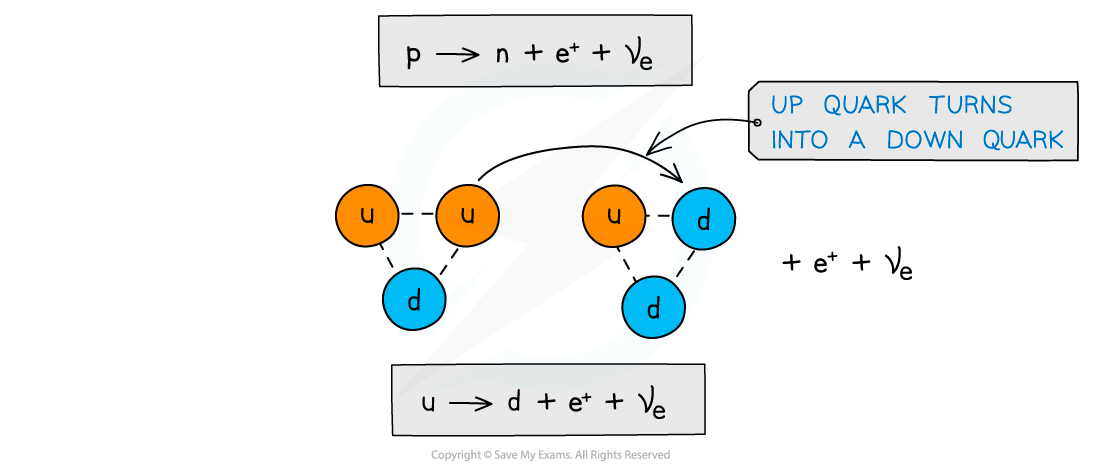
Beta plus decay is when an up quark turns into a down quark
Worked Example
The equation for β– decay is Using the quark model of beta decay, prove that the charge is conserved in this equation.
Using the quark model of beta decay, prove that the charge is conserved in this equation.
